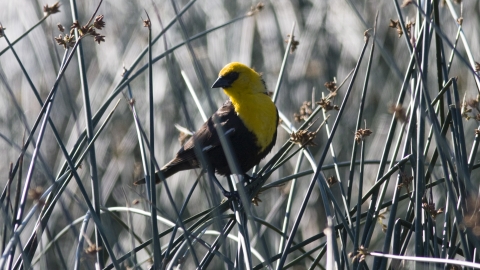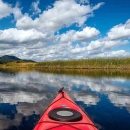Visit Us
Medicine Lake National Wildlife Refuge was set aside to protect the wildlife heritage of the United States. A valuable part of protecting that heritage includes providing opportunities for people to enjoy wildlife through photography, observation, hunting, fishing, and environmental education. The annual migration of hundreds of thousands of birds makes Medicine Lake a premier destination for birdwatchers and wildlife photographers. Waterfowl and upland bird hunters also find quality opportunities. Winter brings ice fishing opportunities for northern pike in Medicine Lake.
Location and Contact Information
About Us
The primary role of the refuge is to conserve its diverse wetlands and grasslands as a refuge and breeding ground for migratory birds and other wildlife. Grassland nesting species such as the chestnut collared longspur, Baird’s sparrow, McCown’s longspur and grasshopper sparrow thrive on the refuge. The refuge’s large pelican colony has been in existence since at least 1939 and is one of the largest colonies in the United States, with about 3,000 to 5,000 nest each year.
The Refuge lies within the highly productive Prairie Pothole Region of the Northern Great Plains. As is typical of what is known as "glacial drift prairie," the Refuge has relatively gentle rolling plains and numerous shallow wetlands. The Refuge encompasses 31,660 acres in Sheridan and Roosevelt counties, and includes about 13,010 acres of open water and marsh, 14,890 acres of native prairie, and 3,760 acres of previously cultivated lands now maintained mostly in perennial grass plantings. Most of the surrounding private land is intensively farmed for small grain.
The Refuge consists of two separate tracts of land. The main tract includes the 8,218-acre Medicine Lake, five smaller lakes, and numerous potholes. The smaller tract lies to the south of the larger one, and contains the 1,280-acre Homestead Lake. Within the main tract of the Refuge, the 11,360-acre Medicine Lake Wilderness was established by Congress in 1976. This area includes the main water body of the lake, the islands within, and the 2,320-acre Sandhills Unit. The Sandhills Unit includes rolling hills, native grass, brush patches, and a few relic stands of quaking aspen. The wilderness portion of the lake is located on the east side of Montana state highway 16. The Sandhills Wilderness area is located southeast of the main lake along Lakeside Road.
Tours
The refuge has 19 miles of public roads, including a 14-mile auto tour route.The auto tour takes visitors through a variety of grassland and wetland habitats, and offers opportunities for wildlife viewing, birding and photography. The auto tour is open to the public approximately 8 months out of the year.
Located at Refuge Headquarters, the 99-foot watch tower offers unique views of Medicine Lake. After undergoing renovations, the tower is now open for climbing most of the year, weather permitting.For more information and to access the tower please call the Refuge at 406-789-2305 or stop by the office at 223 North Shore Road, Medicine Lake, Montana.
Located 3.6 miles from Refuge Headquarters, the recreation area is located off Montana State Highway 16.The recreation area offers interpretive signs, picnic tables, a hiking trail, and an outdoor restroom.
Offering views of colonial nesting birds, Pelican Overlook is located on the east side of the refuge near Bridgerman Point.This site has a raised overlook with all season binoculars and is accessible by vehicle most of the year.
What We Do
Wildlife conservation is at the heart of the National Wildlife Refuge System. It drives everything on U.S. Fish and Wildlife Service lands and waters managed within the Refuge System, from the purposes for which a national wildlife refuge national wildlife refuge
A national wildlife refuge is typically a contiguous area of land and water managed by the U.S. Fish and Wildlife Service for the conservation and, where appropriate, restoration of fish, wildlife and plant resources and their habitats for the benefit of present and future generations of Americans.
Learn more about national wildlife refuge is established to the recreational activities offered to the resource management tools used. To help plants and wildlife, Medicine Lake National Wildlife Refuge staff use a variety of habitat management techniques to maintain, recover, and enhance plants and wildlife. Refuge staff carefully consider different management techniques and the most effective ways to use them.
Our Organization
Our Species
The refuge complex provides breeding and migration habitat for a diverse group of bird species. Medicine Lake National Wildlife Refuge has been designated one of the top 100 Globally Important Bird Areas in the United States by the American Bird Conservancy.
The importance of this area to breeding and migrating waterfowl has long been recognized and was the primary reason for the purchase of the refuge. The density of breeding duck pairs is the highest in the Missouri Coteau. Most common nesting ducks are mallard, gadwall, northern pintail, northern shoveler, blue-winged teal, a total of 14 species breeding locally. The wetlands provide habitat for many colonial-nesting water-birds, including western and eared grebes, California and ring-billed gulls, double-crested cormorants, great blue herons and American white pelicans.
Sharped-tail grouse are one of the few native prairie birds that are year round residents.
Projects and Research
Research projects on the Refuge take place in all seasons and range from working with fish and wildlife to their different habitats. Research and projects are designed to inform management in making the best possible decisions for wildlife and wildlife habitat.



